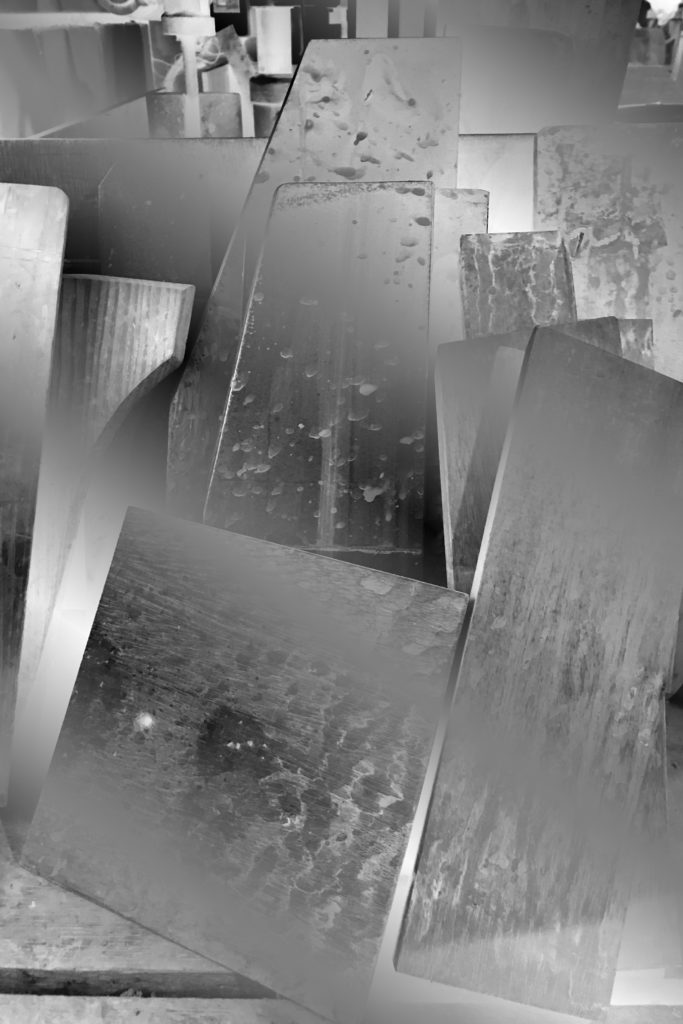Ghost of Copy
松延総司
Soshi Matsunobe
26 July – 11 October, 2021
© Soshi Matsunobe, 2021. Ghost of Copy (Gray) #21, Photograph.
.
|
「無形のもの」を捉えること。それは松延総司が変わることなく追求してきたテーマである。影を追っては、穴を探検し、隙間を調査しては、コンセプチュアル・アートの理論やミニマリストのモデルを使い、地「面」(または背「面」であろうか)を描いてきた。空間の物理性、あるいはその欠乏、箱や輪ゴムや小石といった、ほとんど注目されることのない、日常に存在する万物の美しさに対して、確かな関心を抱き、10年にわたって、彫刻やインスタレーション、ドローイング、写真の制作に取り組んできた。
.
点同士を接合する線、そして抽象の理論に対する興味の先には、松延総司の作品の根本的な特徴として、空間を静かに占める「虚無」がある。何かが「空」であることの荘厳な様子や、空白が醸す優雅、それらの流動的な状態を捉えようとする緻密な努力。松延の作品の魅力は、芸術とは硬直性や自己完結性に囚われず、変容しうるものであるという信念と、その無限性を表現していることにある。作品の美しさは、作品を生み出す制作過程と同様に、その捉えどころのなさに由来している。これらの作品は一瞬の静けさや、何かを沈思する瞬間を象っているのではないか。
.
作品の多くからは「無限性」が感じ取られる。決して掴めない影、見えそうで見えない光など、流動性が表現されている。例えば、手書きの斜線で埋め尽くされた壁紙や看板は、幾何学的なのか、有機的なのか。一見、具象的なようでもあるが、確実に抽象的であり、白黒(距離を取ると灰色に見える)の無限なシーケンスを創り上げているが、それはブラウン管アナログテレビの砂嵐(ノイズ)でランダムに現れる点のピクセル模様にも似ている。それなのに、近くでまじまじ見てみると、シンプルで優雅な美がある。瞬間的に捻られた輪ゴムが、黒い背景に浮いて「曲芸」を演じる、輪ゴムを題材とした写真(2012年、2018年)でも同様だ。我々の日常生活に当たり前のように存在する輪ゴムでさえ、驚くほど生と個性(そう、個性と言って何が悪い)であふれている。小綺麗でシンプルなのに、もつれて複雑な面を持っているのは、人間の人生さながらだ。
.
松延総司は今回、ザ・コンテナーで「Ghost of Copy」シリーズより新旧両方の写真作品を展示する。照明が落とされ、親密な雰囲気の展示空間を活かした、サイト・スペシフィックなインスタレーションである。滋賀の農村に置く彼の仕事場、スタジオ、周辺の自然、陶芸工房、彼の日常生活に登場するランダムなオブジェなど、様々なものや模様を描いた写真が発表される。彼の言葉を借りると、それぞれ、「反射、反転、反復」を強調する操作がなされている。また、イメージの魅力は、彼の他の作品でもそうだが、モチーフにヒエラルキーがないことと、正負のスペースの欠如にある。松延の制作活動全体に通じて言えるが、何かを定義することを避け、「中間」を捉える力は、ポジティブとネガティブが平穏に共存する抽象の尖点にイメージを創り上げ、被写体そのものではなく、その痕跡を強調する。
.
グレースケールを優先し、デッドスペースを取り除くことで「相似」が写し出されていることも特徴的だ。それはつまり、リアルとバーチャル、具象と抽象、自然と人工、軽さと重さの接合だ。作品中、最も興味深いのは、幾何学的なものと抽象的なもの、自然物と人工物の「中間」が模倣されていることだ。どの正反対の境界も、―白と黒の間を繋ぐような― 美学的な方法によって、距離が埋められている。例えば、農業をテーマとした写真作品は、有機的な形状を一旦彷彿させるが、その模様は他方で、農業の機械化と大量生産を象徴しているのではないか。植物を被写体とした作品では、自然と数学の両方で現れる、幾何学とテッセレーション(平面充填)の模様が意識されており、19世紀後半から20世紀前半にかけ自然の形状と幾何学の関係性を表現したドイツ人写真家のカール・ブロスフェルトへのオマージュでもある。
.
本インスタレーションでは、ローテクなカルーセル・スライドプロジェクターを使って、「Ghost of Copy 」シリーズより約80枚の写真をザ・コンテナーの後方壁に投影する。この写真は、松延総司が10年以上にわたって考えてきたコンセプトや美学の多くが強調されており、彼の実践が要約されたかのようである。また、反復的なメカニズムで再生されるスライド・プロジェクションはバーチャルなスケッチブックのように作品を文脈化し、 哲学的で美しく、生理学的で知的な卓越した物語の表象を可能にしている。
|
Soshi Matsunobe is in a perpetual search for means to capture the intangible. He chases shadows, explores holes, investigates gaps, and draws grounds (or rather backgrounds) while using conceptual art theories and minimalist models. Over the last decade he created works in sculpture, installation, drawing, and photography with a clear interest in the physicality of spaces, or lack thereof, and the rarely discussed beauty of the most mundane everyday objects—from boxes and rubber bands to stones.
Beyond his obsession with lines, the meeting forged between dots, and theories of abstractions, the essence of his works lays in the voids that silently fill existence: the sublimity of emptiness, the elegance of blanks, and the relentless efforts to conquer states in flux. The allure of his works inhabits in boundlessness and in the belief that art can be transformative and not constrained by rigidity and self-containment. The beauty of the works, like the processes that created them, derive from their elusiveness. They communicate instants of tranquillity, moments of contemplation, and pundit challenges. There is a sense of infinity in many of his works. Like the shadows he never seems to catch or the light that is almost there, but keeps on moving. You find it in the never ending hand-drawn repeated patterns that permeate his wallpapers and billboards—maybe geometric and maybe organic, kind of figurative but certainly abstract—creating a sequence that is limitless, black and white (but definitely gray, at least from a distance) and typified by their similarity to the random dot pixel pattern of static noise on analog CRT televisions, but also are so elegant and simple upon closer inspection. Same in his inexhaustible photographs of natural crepe rubber bands (2012 and 2018) against a black background, floating in a void, showcasing “acrobatics” after a quick twist in the artist’s palm. The innate and mundane rubber band commands a life and character (there, I said it) in a most surprising manner. It is clean and simple, but knotted and complex, like life itself. At The Container Matsunobe is presenting new and older images from his ongoing series Ghost of Copy, in a site-specific installation that makes use of the dark and intimate environment of the exhibition space. The series captures in photography a range of objects and patterns from the artist’s everyday life—his workplace in the agricultural surroundings of Shiga prefecture, his studio, nature, ceramic workshop, and random objects around him. The photographs are manipulated to emphasize, in the artist’s words, “reflection, reversal, and repetition.” The strength of the images, as in Matsunobe’s other projects, is the lack of a hierarchy of motifs and the absence of negative and positive spaces. As in the rest of his practice, his ability to avoid definition and to capture the “in between” creates images on the cusp of abstraction where positives and negatives coexist peacefully and underscore the traces instead of the objects themselves. The images are characterized by prioritizing a grayscale and fabricating similitude deprived of dead spaces. It’s the juncture of the real and virtual, the weightless and massive, the figurative and abstract, the natural and manmade. Most fascinating is the mimesis between the geometric and abstract and the manmade and natural. In both instances, the borders between the diametrical assumptions are bridged by aesthetic tools, just like Matsunobe manages to consolidate the gaps between blacks and whites. The agricultural images, for example, although recall organic forms, are essentially reflections of mass production, and outline the mechanization of farm work. Such are the images Matsunobe takes of plants, with a node to geometry and patterns of tessellation, common both in natural forms and in math, and an ode to the depictions of the German photographer Karl Blossfeldt who highlighted the relation between natural forms and geometry in late 19th century and early 20th century. The installation sees some eighty images from Matsunobe’s Ghost of Copy projected onto the back wall of The Container, using a low-tech carousel slide projector. The images seem to sum up Matsunobe’s entire practice, accenting many of the conceptual and aesthetic notions he has been contemplating for over a decade. Withal, the repetitive mechanism of the slide projection helps to contextualize the works and setting in a form akin to a virtual sketch book that leads the viewers through a transcendent narrative that is as beautiful as philosophical, and as cerebral as physiological.
|
